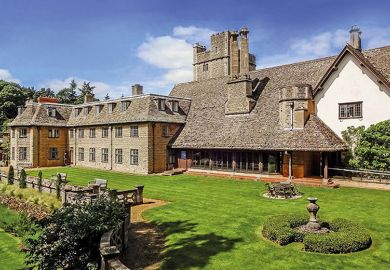The Essex new town of Harlow has been harbouring a secret for the past 50 years: a campus of Canada’s Memorial University of Newfoundland, which follows a “completely different model” to the standard overseas branch venture and is considering starting some local recruitment.
The campus was created in 1969, two years after Lord Taylor of Harlow, a former Labour MP and minister, became the vice-chancellor of Memorial. The university’s main home is in St John’s, capital of the Newfoundland and Labrador province, a city that can trace its history back to 1519.
Lord Taylor had a “romantic notion” about “the newest town in the old world and the oldest town in the new world establishing a relationship”, said Noreen Golfman, provost and vice-president (academic) at Memorial.
The campus was established in former maltings and disused school buildings in Old Harlow, with further buildings including a former butcher’s shop and cottages acquired subsequently, meaning that 60 students can now be accommodated.
All Memorial students “have pathways” to spending “at least one semester or part of a semester…at Harlow”, said Professor Golfman. For students from rural parts of Newfoundland and Labrador in particular, the experience can be “transformative”, she added.
Harlow is just outside London. So Memorial theatre students can “hop on a train and go see a play in the West End”, an “astonishingly privileged experience for them”, said Professor Golfman. They then “go back to Harlow and spend their days in their workshops or sessions with their instructors talking about what they have seen”, blending the “academic and experiential”, she continued.
Art history and visual art students also benefit from proximity to London’s galleries, while business courses and history are also part of the course rotation at the campus. Lecturers travel over from Canada with the students.
This is a “completely different model” from the conventional Western branch campus model, said Professor Golfman.
The “scale is modest compared with, I think, the overreaching of other universities that have invested in bricks and mortar or refurbished bricks and mortar, and then imagined the branch campus as what we would typically call a cash cow to offset budget reductions…on their home campuses”, she continued. “Harlow was never conceived that way.”
Harlow – a town without its own university – has seen a lot of growth in recent years and Memorial has been “talking increasingly, engaging more, with the council”, said Professor Golfman.
There was an idea to “perhaps even lure some [local] students in for a course or two and maybe make the traffic go the other way – encourage people to come to our university [in Canada]”, she said. “Things are opening up and the world has gotten a lot smaller – so who knows, there might be some potential there.”
In the eyes of some in the UK, Harlow would not be regarded as a glamorous place. What do Canadian students make of it?
“There’s that whole snobbery about Essex…people have all kinds of attitudes about various places, especially new towns,” acknowledged Professor Golfman. “But our students are largely oblivious.”
In fact, they are “completely charmed” by Old Harlow, she said. “It matches some…idea of Old England – they might be shortly disabused of that.”
But Old Harlow’s pubs and tranquillity are “very appealing to our students and they are very fond of the place”, she said.
POSTSCRIPT:
Print headline: Essex campus ‘charms’ Canadians
Register to continue
Why register?
- Registration is free and only takes a moment
- Once registered, you can read 3 articles a month
- Sign up for our newsletter
Subscribe
Or subscribe for unlimited access to:
- Unlimited access to news, views, insights & reviews
- Digital editions
- Digital access to THE’s university and college rankings analysis
Already registered or a current subscriber? Login










